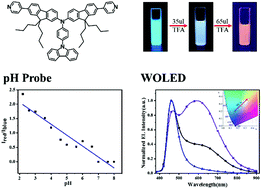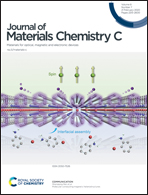Protonation-induced dual fluorescence of a blue fluorescent material with twisted A–π–D–π–A configuration†
Abstract
In this work, we introduced a blue fluorescent material with twisted A–π–D–π–A configuration, namely CzPA-F-PD. This compound exhibits remarkable dual fluorescence properties triggered by trifluoroacetic acid (TFA), resulting in blue and red emission peaks under both the photoluminescence and electroluminescence processes. The reversibility of the dual fluorescence can be triggered by neutralizing TFA with triethylamine (TEA). By spectral measurement and analysis, it is identified that hydrogen protonation of TFA amplifies the lone pair electrons around the nitrogen atoms in pyridine and enhances the electron acceptor ability, which play a major role during the dual fluorescence process. In addition, CzPA-F-PD can be used as a sensitive fluorescent probe for pH monitoring. Furthermore, CzPA-F-PD can also serve as the white emission single layer with some amount of TFA in a solution-processed OLED, which expresses CIE coordinates of (0.36, 0.37) and a high current efficiency of 6.37 cd A−1. Unprecedentedly, the high single exciton utilization efficiency is up to 67.8%, exceeding the upper limit (25%) of traditional fluorescent materials.



 Please wait while we load your content...
Please wait while we load your content...